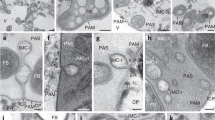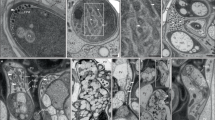Summary
Electron microscopy of protocorms of Dactylorhiza purpurella infected with a symbiotic Rhizoctonia sp. showed that the intracellular hyphae examined did not penetrate the plasmalemma of the host cell. Walls of hyphae within cells bore many hemispherical protuberances over which the host plasmalemma was closely pressed. we estimate that these protuberances would increase the area of contact between hyphae and host plasmalemma by about 15%. They were not found on hyphae growing on agar. Except for these protuberances, and some vesicles or tubules which invaginated the fungus plasmalemma, no other structures were seen which could be suggested to be adaptations to transport across the living fungus-host interface.
Similar content being viewed by others
References
Bracker, C. E.: Ultrastructure of the haustorial apparatus of Erysiphe graminis and its relationship to the epidermal cell of barley. Phytopathology 58, 12–30 (1968).
Branton, D.: Fracture faces of frozen membranes. Proc. nat. Acad. Sci. (Wash.) 55, 1048–1056 (1966).
Burgeff, H.: Mycorrhiza of orchids. The orchids; a scientific survey, p. 361–395, ed. C. Withner. New York: Ronald Press 1959.
Dörr, I., Kollmann, R.: Fine structure of mycorrhiza in Neottia nidus-avis (L.) L. C. Rich. (Orchidaceae). Planta (Berl.) 89, 372–375 (1969).
Gunning, B. E. S., Pate, J. S.: “Transfer cells”. Plant cells with wall ingrowths, specialised in relation to short distance transport of solutes—their occurrence, structure and development. Protoplasma 68, 107–133 (1969).
Hadley, G.: Cellulose as a carbon source for orchid mycorrhiza. New Phytol. 68, 933–939 (1969).
—: Non-specificity of symbiotic infection in orchid mycorrhiza. New Phytol. 69, 1015–1023 (1970).
—, Williamson, B.: Analysis of the post-infection growth stimulus in orchid mycorrhiza. New Phytol. 70, 445–456 (1971).
Harley, J. L.: The biology of mycorrhiza, 2nd ed. London: Leonard Hill 1969.
Moor, H.: Plantin-Kohle-Abdruck-Technik angewandt auf den Feinbau der Milchröhren. J. Ultrastruct. Res. 2, 392–422 (1959).
—, Mühlethaler, K.: Fine structure in frozen-etched yeast cells. J. Cell Biol. 17, 609–629 (1963).
Smith, S. E.: Carbohydrate translocation in orchid mycorrhizas. New Phytol. 66, 371–378 (1967).
Venable, J. H., Coggeshall, R.: A simplified lead citrate stain for use in electron microscopy. J. Cell Biol. 25, 407–408 (1965).
Williamson, B.: Induced DNA synthesis in orchid mycorrhiza. Planta (Berl.) 92, 347–354 (1970).
Author information
Authors and Affiliations
Rights and permissions
About this article
Cite this article
Hadley, G., Johnson, R.P.C. & John, D.A. Fine structure of the host-fungus interface in orchid mycorrhiza. Planta 100, 191–199 (1971). https://doi.org/10.1007/BF00387035
Received:
Issue Date:
DOI: https://doi.org/10.1007/BF00387035




